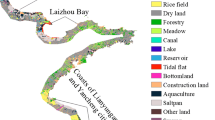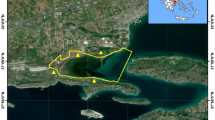Abstract
The availability of wetlands and shallow water habitats significantly influences Gulf of Mexico (GOM) penaeid shrimp fishery productivity. However, the GOM region has the highest rate of wetland loss in the USA. Protection and management of these vital GOM habitats are critical to sustainable shrimp fisheries. Brown shrimp (Farfantepenaeus aztecus) are a major component of GOM fisheries. We present an approach for estimating the areal extent of suitable habitat for post-larval and juvenile brown shrimp in Mobile Bay, Alabama, using an existing habitat suitability index model for the northern GOM calculated from probabilistic survey of water quality and sediment data, land cover data, and submerged aquatic vegetation coverages. This estuarine scale approach is intended to support targeted protection and restoration of these habitats. These analyses indicate that approximately 60% of the area of Mobile Bay is categorized as suitable to near optimal for post-larval and juvenile shrimp and 38% of the area is marginally to minimally suitable. We identify potential units within Mobile Bay for targeted restoration to improve habitat suitability.
Similar content being viewed by others
References
Beck, M. W., Odaya, M., Bachant, J. J., Bergan, J., Keller, B., Martin, R., et al. (2000). Identification of priority sites for conservation in the northern Gulf of Mexico: An ecoregional plan. Arlington: The Nature Conservancy.
Boesch, D. F., & Turner, R. E. (1984). Dependence of fishery species on salt marshes: The role of food and refuge. Estuaries, 7(4A), 460–468.
Brown, S. K., Buja, K. R., Jury, S. H., & Monaco, M. E. (2000). Habitat suitability index models for eight fish and invertebrate species in Casco and Sheepscot Bays, Maine. North American Journal of Fisheries Management, 20, 408–435.
Christmas, J. Y., Gunter, G., & Musgrave, P. (1966). Studies on annual abundance of postlarval penaeid shrimp in the estuarine waters of Mississippi as related to subsequent commercial catches. Gulf Research Reports, 9(9), 117–212.
Clark, R. D., Christensen, J. D., Monaco, M. E., Caldwell, P. A., Matthews, G. A. & Minello, T. J. (2004). A habitat-use model to determine essential fish habitat for juvenile brown shrimp (Farfantepenaeus aztecus) in Galveston Bay, Texas. Fisheries Bulletin, 102, 264–277.
Davies, S. P. & Jackson, S. K. (2006). The biological condition gradient: A descriptive model for interpreting change in aquatic ecosystems. Ecological Applications, 16(4), 1251–1266.
Garcia, S. & LeReste, L. (1981). Life cycles, dynamics, exploitation and management of coastal penaeid shrimp stock. FAO Fisheries Technical Paper, 215 p.
Gulf of Mexico Alliance (2006). Governors’ action plan for healthy and resilient coasts: March 2006–March 2009. Available at http://www.dep.state.fl.us/gulf/files/files/GulfActionPlan_Final.pdf (last visited June 14, 2006).
Gunter, G. (1967). Some relationships of estuaries to the fisheries of the Gulf of Mexico. In G. H. Lauff (Ed.), Estuaries (pp. 621–638). Washington: American Association of the Advancement of Science.
Hass, H. L., Rose, K. A., Fry, B., Minello, T. J. & Rozas, L. P. (2004). Brown shrimp on the edge: Linking habitat to survival using an individual-based simulation model. Ecological Applications, 14(4), 1232–1247.
Heck, K. L. Jr., Hays, G., & Orth, R. J. (2003). Critical evaluation of the nursery role hypothesis for seagrass meadows. Marine Ecology Progress Series, 253, 123–136.
Houde, E. D., & Rutherford, E. S. (1993). Recent trends in estuarine fisheries: Predictions of fish production and yield. Estuaries, 16, 161–176.
Howe, J. C., & Wallace, R. K. (2000). Relative abundance of postlarval and juvenile penaeid shrimps in submerged aquatic vegetation and emergent marsh habitats. Gulf of Mexico Science, 2, 130–137.
Howe, J. C., Wallace, R. K., & Rikard, R. S. (1999). Habitat utilization by postlarval and juvenile penaeid shrimps in Mobile Bay, Alabama. Estuaries, 22(4), 971–979.
Jordan, S. J., Smith, L. M., & Nestlerode, J. A. (2009). Cumulative effects of coastal habitat alterations on fishery resources: Toward prediction at regional scales. Ecology and Society, 14(1), 16.
Lassuy, D. R. (1983). Species profiles: Life histories and environmental requirements (Gulf of Mexico)-brown shrimp. U.S. Fish Wildl. Serv., Division of Biological Services. FWS/OBS-82/11.1. U.S. Army Corps of Engineers, TR EL-82-4. (pp. 15).
Loesch, H. (1965). Distribution and growth of penaeid shrimp in Mobile Bay, Alabama. Publications of the Institute of Marine Sciences, University of Texas, 10, 41–58.
McHugh, J. L. (1967). Estuarine nekton pp. 581–620. In: G. Lauff (ed.), Estuaries. American Association for the Advancement of Science. Publ. No. 83.
Minello, T. J. & Zimmerman, R. J. (1983). Fish predation on juvenile brown shrimp, Penaeus aztecus Ives: The effect of simulated Spartina structure on predation rates. Journal of Experimental Marine Biology and Ecology, 7, 211–231.
Minello, T. J., & Zimmerman, R. J. (1985). Differential selection for vegetative structure between juvenile brown shrimp (Penaeus aztecus) and white shrimp (P. setiferus), and implications in predator–prey relationships. Estuarine, Coastal and Shelf Science, 20, 707–716.
Minello, T. J., Zimmerman, R. J., & Martinez, E. X. (1987). Mortality of young brown shrimp Penaeus aztecus in estuarine nurseries. Transactions of the American Fisheries Society, 118, 693–708.
Nance, J. M., Klima, E. F., & Czapla, T. E. (1989). Gulf of Mexico shrimp stock assessment workshop (p. 41). NOAA Technical Memorandum, NMFS-SEFC-239.
Nance, J. M., Martinez, E. X. & Klima, E. F. (1994). Feasibility of improving the economic return from the Gulf of Mexico brown shrimp fishery. North American Journal of Fisheries Management, 14, 522–536.
National Oceanic and Atmospheric Administration (NOAA) (2003). Fisheries of the United States 2002. National Marine Fisheries Service, Office of Science and Technology, Fisheries Statistics and Economics Division. Maryland: Silver Spring.
O’Connor, T. P., & Matlock, G. C. (2005). Shrimp landing trends as indicators of estuarine habitat quality. Gulf of Mexico Science, 2, 192–196.
Saoud, I. P., & Davis, D. A. (2003). Salinity tolerance of brown shrimp Farfantepenaeus aztecus as it relates to postlarval and juvenile survival distribution and growth n estuaries. Estuaries, 26(4A), 970–974.
Stevens, D. L., Jr. (1997). Variable density grid-based sampling designs for continuous spatial populations. Environmetrics, 8, 167–195.
Summers, J. K., Paul, J. F., & Robertson, A. (1995). Monitoring the ecological condition of estuaries in the United States. Toxicological and Environmental Chemistry, 49, 93–108.
Turner, R. E. (1977). Intertidal vegetation and commercial yields of penaeid shrimp. Transactions of the American Fisheries Society, 106, 411–416.
Turner, R. E. (2001). Of manatees, mangroves and the Mississippi River: Is there an estuarine signature for the Gulf of Mexico? Estuaries, 24(2), 139–150.
Turner, R. E., & Brody, M. S. (1983). Habitat suitability index models: Northern Gulf of Mexico brown shrimp and white shrimp. U.S. Dept. of Int. Fish Wildl. Serv. FWS/OBS-82/10.54. 24 p.
U.S. Environmental Protection Agency (USEPA) (2004). National coastal condition report II. EPA-620/R-03/002. Washington: Office of Water.
U.S. Environmental Protection Agency (USEPA) (2006). Strategies for protecting public health and the environment: Protect coastal and ocean waters. In National water program guidance for FY 2007 (p. 70). Washington: Office of Water. http://www.epa.gov/ocfo/npmguidance/owater/2007/2007_ow_npmguide.pdf.
Vittor, B. A., & Associates. (2004). Mapping of submerged aquatic vegetation in Mobile Bay and adjacent waters of coastal Alabama in 2002: Mobile Ala., prepared for Mobile Bay National Estuary Program (p 27).
Zimmerman, R. J., Minello, T. J., & Zamora, G. (1984). Selection of vegetated habitat by brown shrimp, Penaeus aztecus, in a Galveston Bay salt marsh. Fisheries Bulletin, 82, 325–336.
Author information
Authors and Affiliations
Corresponding author
Rights and permissions
About this article
Cite this article
Smith, L.M., Nestlerode, J.A., Harwell, L.C. et al. The areal extent of brown shrimp habitat suitability in Mobile Bay, Alabama, USA: targeting vegetated habitat restoration. Environ Monit Assess 171, 611–620 (2010). https://doi.org/10.1007/s10661-009-1303-0
Received:
Accepted:
Published:
Issue Date:
DOI: https://doi.org/10.1007/s10661-009-1303-0




